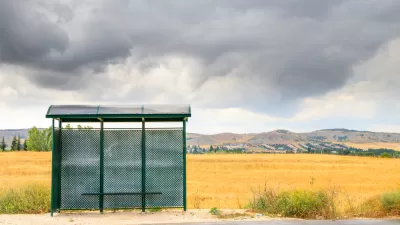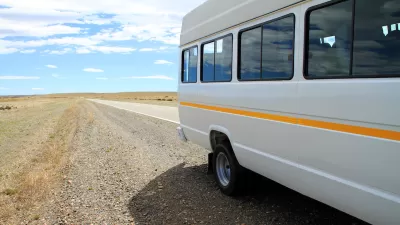Funding cuts and uneven investment in rural areas have left millions of Americans trapped without adequate transportation.

Dwindling funding for transit systems, particularly those in less dense, non-urban areas, is having a major impact on rural Americans who don't own cars or are unable to drive.
While conversation around public transit tends to focus on big cities, many people in small towns and rural communities also depend on it. "For many Americans, public transit is the only option to get to work, school, the grocery store, or doctor’s appointments. But nearly half of us have no access to public transit. And those that do are now confronting limited routes, slashed service times, and limited disability accommodations," writes Kayla Soren. For people with disabilities, the burden of reduced transit is even greater. "Over 80 percent of young adults with disabilities are prevented from doing daily activities due to a lack of transportation," and overstretched transit agencies often don't have the resources to accommodate riders with disabilities.
With millions of Americans lacking access to public transit and many more forced to depend on inadequate transportation, Soren argues that Congress should step in with emergency relief and increased federal funding to public transit agencies, including an adjustment to "the '80-20' split that’s plagued federal transit funding since the Reagan era — with 80 percent going to highways and less than 20 percent to public transit." Although commonly justified by the belief that only residents of big cities use transit, "this is upside-down logic. The hearings reveal that when people don’t use transit, it’s because it is nonexistent, unreliable, or inaccessible."
FULL STORY: Small Towns And Rural Communities Need Transit, Too

Trump Administration Could Effectively End Housing Voucher Program
Federal officials are eyeing major cuts to the Section 8 program that helps millions of low-income households pay rent.

Planetizen Federal Action Tracker
A weekly monitor of how Trump’s orders and actions are impacting planners and planning in America.

Ken Jennings Launches Transit Web Series
The Jeopardy champ wants you to ride public transit.

Washington Legislature Passes Rent Increase Cap
A bill that caps rent increases at 7 percent plus inflation is headed to the governor’s desk.

From Planning to Action: How LA County Is Rethinking Climate Resilience
Chief Sustainability Officer Rita Kampalath outlines the County’s shift from planning to implementation in its climate resilience efforts, emphasizing cross-departmental coordination, updated recovery strategies, and the need for flexible funding.

New Mexico Aging Department Commits to Helping Seniors Age ‘In Place’ and ‘Autonomously’ in New Draft Plan
As New Mexico’s population of seniors continues to grow, the state’s aging department is proposing expanded initiatives to help seniors maintain their autonomy while also supporting family caregivers.
Urban Design for Planners 1: Software Tools
This six-course series explores essential urban design concepts using open source software and equips planners with the tools they need to participate fully in the urban design process.
Planning for Universal Design
Learn the tools for implementing Universal Design in planning regulations.
Heyer Gruel & Associates PA
Ada County Highway District
Institute for Housing and Urban Development Studies (IHS)
City of Grandview
Harvard GSD Executive Education
Toledo-Lucas County Plan Commissions
Salt Lake City
NYU Wagner Graduate School of Public Service





























